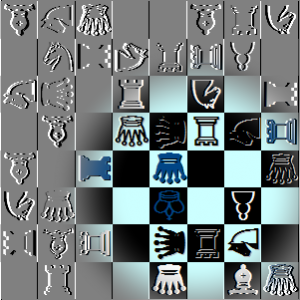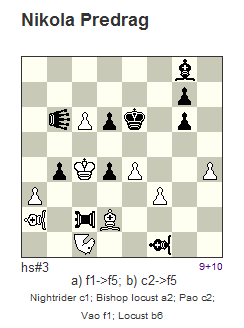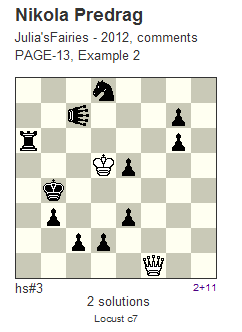|
|
Original Problems (page 13)I’ll publish some of my problems here and I’d be happy to receive yours! Diagrams, comments, new ideas, anything to discuss – are very appreciated! The site is mostly about fairies, but h# and s# are also welcome! Please send your problems to my e-mail: julia@juliasfairies.com Go to >>> Page 12 ; >>> Page 14 |
Presenting to you a new nice problem by Nikola Predrag, which demonstrates his lovely theme the last days – creation of batteries with Locust as rear battery-piece. In Nikola’s problem below this actual for this site theme is combined with interesting play of black B/R battery. See:
No.35 – hs#3 by Nikola Predgrag
See all Definitions in Fairy Terms section or click the fairy piece or condition below to go right to its definition on that page:
|
–
No.35 Nikola Predrag
(Сroatia)
original
–
 hs#3 2 solutions (2+6)
Nightrider b7
Locust c3
–
Solutions:
I. 1.Nd3 Bd5 + 2.Ke3 Bf3 3.Nh5 + Bxh5 #
II. 1.Bf6 Be6 + 2.Ke5 Rd4 3.Bh4 + Rxh4 #
–
Showing another Dentist (ref. to No.33, Page-11), one Locust acting orthogonally and diagonally.(Author)
|
The diagrams are made on WinChloe and its Echecs font is used for Logo design



Reciprocal Dentist-functions and flight-guards by w Nb7/Bg5 and by b Ra4/Bc4. In solution II bR has the open rank to play to h4 but first must play to d4 which highlights the thematic unpin of wBf6. I would be happy if in solution I bB could play 1…Be2 and then first Bf3 on the open line to h5. Well, I didn’t manage that. 🙁
Dear Nikola,
Please, look at this version with a Princess on c4, remove bPf7 and add wPe6:
White Nb7 Pe6 Bg5 Ke4 Bh3 Pg2
Black Pc7 Ra4 PRc4 Pa3 Lc3 Kg3 Ph2
Stipulation hs#3
2 solutions
wNightrider b7, bLocust c3, bPrincess c4
1.Nb7-d3 PRc4-e5 + 2.Ke4-e3 PRe5-f3 3.Nd3-h5 + PRf3*h5 #
1.Bg5-f6 PRc4-e3 + 2.Ke4-e5 Ra4-d4 3.Bf6-h4 + Rd4*h4 #
Janos Mikitovics
Dear Janos,
Thanks for the suggestion. I don’t see the benefit of Princess. It is another fairy piece, stronger but still not more functional than the orthodox bishop in this position. With wP instead of bP, the economy is clearly worse. Perhaps I don’t see some thematic benefit.
Dear Nikola,
You’re right! The “new version” is not better… only the exchange of squares motivated me:
I. 1… PRe5 + (a) 2.Ke3 (b)
II.1…PRe3 + (b) 2.Ke5 (a)
No.35 Nikola Predrag – А very interesting problem! The discussion between Nikola and Janos is also very instructive! The main questions in my opinion, there are two: 1. Whether an improvement of this good problem is necessary?; 2. How is possible to make this improvement?
My answers are:
1. Here the play of the black battery B / R is a very interesting thematic component! But both solutions are not quite adequate thematically, because the roles of B and R are different. This fact means somewhat thematic dissonance, which reduces the value of the work, though not very significant. Therefore, it is possible and interesting to experience improvement, retaining the interesting additional component – a play of black battery but with full harmony in both solutions!
2. In the beginning, there is need to fix the location of only two pieces – the black Locust (for example on c3 and the white King (for example on e4)! In this quite elementary position we can try an interesting constructive trick: we create a black battery but with forward piece – the black King!
For example: black King c6, black Bishop a8. OK. The idea: if here white plays on f6/f3 with a figure, Black answer with play of its K/B battery! Theoretically we can write: 1. Xf6 Kc7+! and now White can play 2. Ke5! In this manner, it is possible theoretically to create two fully adequate solutions! These solutions would be probably more interesting than the original, because here is activity on both kings!
Of course, a lot of other black batteries with K as forward piece is possible to create here. But this is just one of many theoretical ways to improve the initial problem! I will not indicate concrete schemes or new problems because I’d be satisfied if Nikola can carry out these experiments alone!
A general my recommendation: if you wish to improve some problem (or even only work-position) your methodical analysis should go from the particular case to the general concept! Practically it means, that You save (fix!) some old, basic components (for example Ke4 and Loc3) but You add to this components new thematic elements not in concrete form but as a theoretical possibility only! For example: we fix Ke4/Loc3 but as theoretic concept we accept: “Some black battery with forward piece black K should play on the first black move, with goals: a) To keep square e4; b) To put the black King on some square where it will finally get a check!”
Further, this theoretical concept should be re-specified! For example: we choose a battery King/Bishop with Kd5/Ba8; or we choose a battery K/N with Kd6/Nc8, etc…
In my personal system for analysis and composition “PAPGS” this method is named: “A general theoretical development with an initial fixed specific minimum” – Here – the general theoretic development means the idea to create a black K-battery which plays against to the w.King; the fixed specific minimum are two pieces: Ke4 and Loc3 which in our future work should be a chess constant!
But, dear friends, it is only my subjective opinion about Nikola`s original!
Dear Mr. Petkov, your ‘subjective’ opinion is most instructive to me and I hope to everyone else. It is clear that you perfectly know what were my constructional troubles and that I have finished the problem when I reached the correct, but not the optimal form!
I shall try to describe some points in the process of making this problem. It might not be interesting to everyone, it’s about the self-confidence and the (im)patience.
wK must not be attacked in the beginning but his initial square must be attacked/guarded in the end. One of the easy ways to achieve that is a black battery. But it took me a lot of time to find that ‘easy’ way. I have some experience and I should have try to use such battery in the beginning of the construction and the problem could have been quickly made. But here the human psychology comes on the scene.
If I have made this position quickly, I would take it as a good and promising ‘work-position’ for further development. But I was discouraged by the hours of a struggle for just that one square and I thought that I was lucky enough to find a correctly working battery mechanism. I was aware that it was not optimal, but I took it as my personal limit.
The conclusion might be that it is irrelevant how much time and work was spent to find a good scheme. If the mechanism does not work optimally, we should take that scheme as the beginning of composing, not as the finished problem. Self-confidence and a lot of work is required to reach the optimum.
This site is endowed with the supreme mentor. The suggestion to use a black royal battery is a noble gift. It depends on my skills how I shall use it.
I am rather embarrased with first correct attempt. The scheme is crowded and the flaws are obvious. I should search for a simplier basic scheme but it’s not easy to abandon and forget the interesting play of Chinese pieces. I give this attempt because it shows the dilemma, should one try to improve this scheme, or start a new search for something different. Good intuition and rich experience may save a composer from wasting time.
Hs#3; Zero-position, a)Move f1 f5; b)Move c2 f5
White Pc6 Kc4 Pe4 Ph4 Pa3 Pf3 LBa2 Bd2 Nc1
Black Bg8 Pg7 Lb6 Pd6 Ke6 Pg6 Pb4 Pd4 PAc2 VAf1
a) bVAf1–>f5, 1.Be3 Kf6+ 2.Kxd4 PAc5 3.Bg5+ PAxg5#
b) bPAc2–>f5, 1.Nb3 Ke5+ 2.Kxb4 VAb5 3.Nd7+ VAxd7#
Illustrating Nikola’s scheme from the comment above:
[img [/img]
[/img]
a) bVAf1–>f5
1.Bd2-e3 Ke6-f6 + 2.Kc4*d4 PAc2-c5 3.Be3-g5 + PAc5*g5 #
b) bPAc2–>f5
1.Nc1-b3 Ke6-e5 + 2.Kc4*b4 VAf1-b5 3.Nb3-d7 + VAb5*d7 #
Thanks Julia, this attempt should only show the difficulties when a composer complicates too much. Probably it doesn’t deserve a diagram after all.
I tried to simplify the scheme with black royal battery. Now bNa4 will guard the initial square of wK but in one solution it is actually necessary to guard g7. The guarding functions of both bR and bB in both mates are achieved rather artificially. So, I didn’t manage to combine naturally the royal battery with the rest of the mechanism (example 1).
This scheme looks more natural without that battery. Still, the guard of d6 by bR in one phase is needed only because bPe5 is on the board (example 2).
Example 1: hs#3, 2.1…
White Ke6 Pc4 Pb3 Qg2
Black Ld8 Be8 Rh7 Pf6 Kc5 Na4 Pf4 Pa3 Pc3 Pd3 Pe3
1.Qd5+ Kb4+ 2.Kd6 Bd7 3.Qb5+ Bxb5#
1.Qg5+ Kd4+ 2.Kf6 Re7 3.Qe5+ Rxe5#
Example 2: hs#3, 2.1…
White Kd5 Qf1
Black Sd8 Lc7 Pg7 Ra6 Pg6 Pe5 Kb4 Pb3 Pe3 Pc2 Pd2
1.Qc4+ Ka5 2.Kc5 Sc6 3.Qb4+ Sxb4#
1.Qf4+ Kc3 2.Kxe5 Rd6 3.Qd4+ Rxd4#
Obviously, much more imagination is required to achieve a convincing and economical mechanism.
Nikola, I believe, it deserves a diagrams!
I like to read your thought and to look at the results.
This is for everyone to see your ideas right here:
[img [/img]
[/img]
1.Qg2-d5 + Kc5-b4 + 2.Ke6-d6 Be8-d7 3.Qd5-b5 + Bd7*b5 #
1.Qg2-g5 + Kc5-d4 + 2.Ke6*f6 Rh7-e7 3.Qg5-e5 + Re7*e5 #
[img [/img]
[/img]
1.Qf1-c4 + Kb4-a5 2.Kd5-c5 Sd8-c6 3.Qc4-b4 + Sc6*b4 #
1.Qf1-f4 + Kb4-c3 2.Kd5*e5 Ra6-d6 3.Qf4-d4 + Rd6*d4 #
Nikola Pregrag ( comments to his versions) [/img]
[/img]
These are interesting improvisations of Nikola!
I. About the ” 0 – position scheme” Kc4/Ke6 (conditionally we can named it as position “A”)
I think, that the zero-position is always a weakness of the problem. In my practice I avoid such positions. Therefore, here the first my serious critical remark to this position is its “0-position” .
One my general recommendation in this regard: always avoid zero-positions, whenever it is possible! If you compose a problem with zero position, you should know that this is a serious weakness of your work!
Another minus of “A” is the excessive use of fairy figures – play of some of them is not sufficiently active and (or) homogeneous. For example – Bishop-Locust on a2 which is a typical static figure. It stands on the diagonal line because we cannot use on a2 white Bishop. Therefore, here the very good element K-battery contra K-battery is realized not sufficiently aesthetically, although this defect is not so big.
In “А” the role of black PAO-c2 and VAO-f1 is not sufficiently adequate – much better is the solution with PAO-f5 where after move 1….Ke5+ we have a creation of an indirect black anti-battery K/PAO (PAO keeps square a5). On the other hand, here after Nb3 we have a preliminary line-closing of the diagonal with a further new line-opening of the same diagonal! But in another solution there is no such motive! These minusеs are probably an “organic deffect” of this scheme.
In this problem we see capturing second moves of White, but these captures are also a weaknesses, of course, because they don’t have thematic character. Heavy construction here is also a serious defect.
OK, but here the main question is: whether this scheme can be improved? We can try a new position in which: a) there is no zero-position; b) we should work not with PAO and VAO but with other piece(s) which execute the role of forward battery pieces; c) we should eliminate the non-thematic captures by the black Pawns; d) The change of batteries K/B and K/BLo is a desirable change, but the question is whether it is possible.
All these reflections lead to the conclusion that here we should leave as constant elements only Kc4/Ke6, LOb6. If we consider that after Nb3 (or other white move on b3) the line-closing is an acceptable minus, we can try as basic scheme the following position: Kc4/Ke6,BLOa2, Bg8 and LOb6! In this elementary scheme we can try whether it is possible to create a good play according to our initial plan from position “A”!
A recommendation: in this scheme we can change also K/batteries , trying such mechanism: Kc4/Kd6, wNb2, bl.Nd8, LOb6.
Recommendation to the young composers : If you need to improve any scheme (or problem), apply the following procedure:
a) Fix all weaknesses of thematic and structural nature of the scheme (problem).
b) Remove the pieces (with thematic importance) which are the causes for these weaknesses, with a tendency later to replace them with other figures, or change the location of the initial figures.
c) The goal is to get a very simple position with some figures that will be your basic, constant (unchangeable) position.
d) Then begins the reverse process: you begin to plan a new way to run already familiar motives, using new thematic pieces or changing the locations of the old thematic figures from the initial scheme.
Practical example: using position “A” by Nikola. We have already implemented procedures for the points a-c and we have as a basic position Kc4/Ke6, BLOa2, Bg8, Lob6! Here we should add white and black pieces with goal to create our Dentist- Mechanism. ОК. Obviously what is needed is one or two black figures who will play on fields b5, c5. In the Start scheme “A” this role was played bad by PAO and VAO because of already mentioned reasons. Are there other options for playing on fields b5,c5 with other figure(s)? Yes, of course! For example, a black BLO would be excellent to play on b5, c5 – we need to check this possibility!! Another option here is to use a black PAO which plays on b5, c5, or other black figure(s). After that we should determine also the white piece(s) which will play on b3,е3. Of course, at this stage we must already have ac а project also moves of the black king and the last (3rd) white moves.
Who can use the basic position Kc4/Kd6, wNb2, bl.Nd8, Lob6, following the cited procedure?
II.
[img
1.Qg2-d5 + Kc5-b4 + 2.Ke6-d6 Be8-d7 3.Qd5-b5 + Bd7*b5 #
1.Qg2-g5 + Kc5-d4 + 2.Ke6*f6 Rh7-e7 3.Qg5-e5 + Re7*e5 #
An interesting version with active play of w.Queen! But here the non thematic capture Kxf6 is a weekness, of course. Practically, these are some ways for improvements: a) To use twins – form; b) To extend the problem to 3,5 or even to 4 moves; c) To change w.Queen as thematic piece with a white Locust (!!), etc.
Another important question here: is it possible to remove black Pawns a3 c3 and change them with a white Pawn b2? The answer is: Yes! And in my opinion, the author should make this correction.
III. [/img]
[/img]
[img
1.Qf1-c4 + Kb4-a5 2.Kd5-c5 Sd8-c6 3.Qc4-b4 + Sc6*b4 #
1.Qf1-f4 + Kb4-c3 2.Kd5*e5 Ra6-d6 3.Qf4-d4 + Rd6*d4 #
White Minimal-problem, but also with a bad capture on f6. My recommendations about eventual improvements are the same as in the previous problem.
At the first sight the white Queen is a good and powerfull piece for realization of this complex, but I’m not sure that in extending of the play to 3,5 and 4 moves this figure will be helpful because of the high risk of cooks.
About Chinese pieces, I repeat – in my opinion – here an excellent play would be realized with the black or(plus) white LEO.
Dear Mr. Petkov, thanks for the rich analysis. Example 1 I actually first made with wPb2 and a twin wPb2->b3, without bP a3&c3. But in these examples I did not care too much about non-thematic features because I was not enough satisfied with the thematic content and mechanism. These are not the versions for authorized publishing. I wanted to illustrate my big troubles to find the proper pieces for the mechanism.
Yesterday I also concluded that black LEO could even greatly enrich the thematic play on the Dentist-line.
Last night I sent you a rough scheme for the idea and few hours ago I sent a much improved version with white LEO too. If you could find my last e-mail, I would be greatful for an advice about that position.